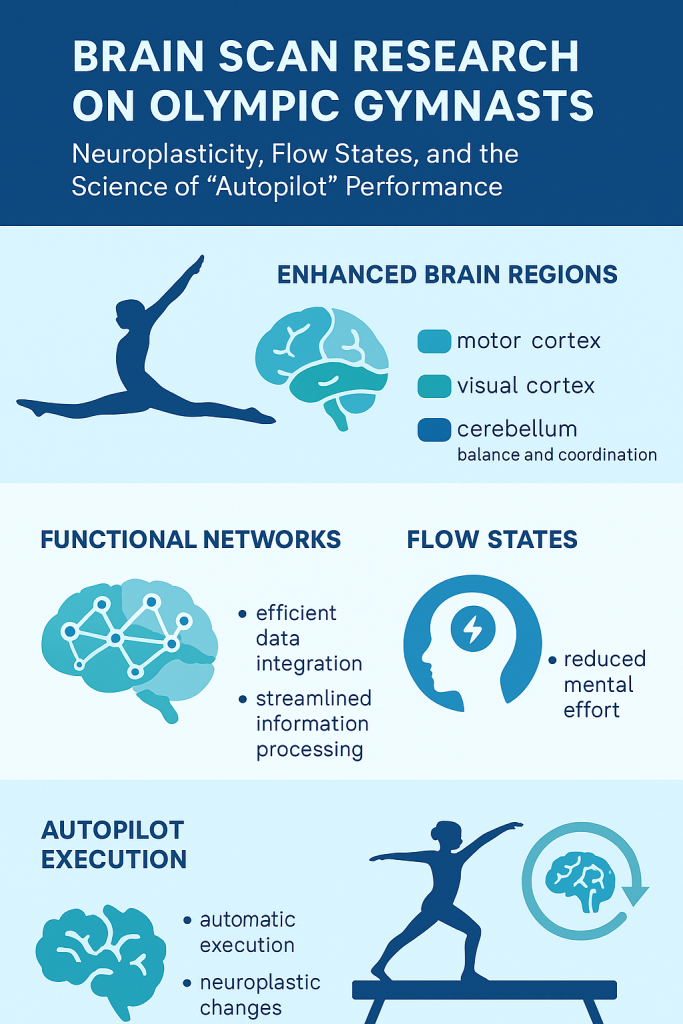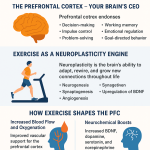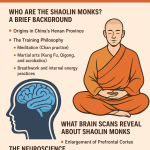Introduction: Training the Brain Like the Body
If you’ve ever watched an Olympic gymnast soar through the air or balance effortlessly on a narrow beam, you’ve probably wondered: How do they make it look so automatic?
The answer lies not only in muscles and years of training, but in the brain itself. Brain scan research on Olympic gymnasts reveals remarkable changes: larger areas related to motor control, vision, and spatial perception, along with more efficient functional networks that allow movements to be executed on “autopilot.”
Far from being fixed, the human brain adapts in profound ways to repetitive, intensive training. Neuroplasticity—the brain’s ability to reorganize itself—turns gymnasts’ practice into structural and functional upgrades. These changes enhance coordination, decision-making, and even the ability to enter flow states, where peak performance feels effortless.
This article explores the science behind these changes, weaving together studies, neuroscience insights, and real-world applications.
The Brain as an Athlete’s Secret Weapon
The Role of the Brain in Elite Performance
Muscles alone can’t explain why gymnasts perform triple flips or stick a perfect landing. Behind every movement lies a network of brain regions coordinating vision, balance, and motor execution.
- Motor cortex: Sends signals to move specific muscles.
- Cerebellum: Fine-tunes timing and balance.
- Parietal lobe: Provides spatial awareness—critical for aerial rotations.
- Occipital lobe: Processes visual input, so gymnasts know where they are in space.
- Basal ganglia: Stores motor “programs” for automated execution.
Why Gymnastics Provides a Unique Lens
Gymnastics combines explosive power, balance, precision, and creativity. Unlike sports with repetitive patterns, gymnastics routines are varied, multidimensional, and mentally demanding. That variety makes gymnasts’ brains a particularly rich subject for neuroplasticity research.
Neuroplasticity: The Brain’s Superpower
Defining Neuroplasticity
Neuroplasticity is the lifelong ability of the brain to adapt by forming new neural connections. Once thought to peak in childhood, research now confirms that adult brains can—and do—reorganize in response to experience.
- Structural plasticity: Physical changes in gray matter volume or cortical thickness.
- Functional plasticity: Shifts in how different regions communicate.
- Synaptic plasticity: Strengthening or weakening of individual connections between neurons.
Gymnastics as a Neuroplasticity Laboratory
Gymnasts challenge the brain on multiple fronts:
- Balance beams demand stability despite instability.
- Aerial flips require real-time spatial recalibration.
- Choreographed routines demand memory, sequencing, and rhythm.
Each challenge strengthens neural circuits, much like lifting weights strengthens muscles.
What Brain Scans of Gymnasts Show
Structural MRI Findings
MRI studies reveal that gymnasts often have:
- Enlarged primary motor cortex regions.
- Thicker cortical areas in the parietal lobe, which handles spatial mapping.
- Increased gray matter in the cerebellum, crucial for balance and timing.
A study by Wei et al. (2011, NeuroImage) compared professional gymnasts to non-athletes, finding thicker motor and parietal cortices in gymnasts.
fMRI Insights: Watching the Brain in Action
Functional MRI allows scientists to observe which brain regions “light up” during tasks. In gymnasts, motor regions activate more efficiently—less effort is needed to perform complex tasks. This suggests that years of training streamline neural communication.
DTI and White Matter Integrity
Diffusion Tensor Imaging (DTI) maps white matter—the brain’s communication highways. Gymnasts show more myelination (insulating layers) in white matter tracts connecting motor and visual areas. Better connectivity translates to faster, more synchronized responses.
EEG and the Flow State
EEG studies highlight shifts in brainwave patterns during routines:
- Increased alpha and theta waves, linked with focus and calmness.
- Decreased beta activity, which normally accompanies conscious control.
This pattern reflects a shift into flow—an automatic, hyper-focused state.
The Autopilot Effect: How Gymnasts Perform Without Thinking
Basal Ganglia and Motor Programs
Once a gymnast has practiced a move thousands of times, execution shifts from conscious control (prefrontal cortex) to the basal ganglia, which stores motor programs. This “autopilot” allows routines to unfold smoothly with minimal conscious thought.
Transient Hypofrontality: Turning Down the Brain’s CEO
During flow, the prefrontal cortex reduces its activity—a phenomenon called transient hypofrontality. This frees gymnasts from self-consciousness and overthinking, letting their trained motor systems take over.
Energy Efficiency in Action
fMRI research shows that expert gymnasts use less brain energy to perform routines than novices. Their networks are optimized, requiring fewer resources for the same action.
Enlarged Brain Regions in Gymnasts
Motor Cortex: The Control Tower
The motor cortex is larger and more active in gymnasts, allowing precise control of complex movements like twists and landings.
Parietal Lobe: The Body’s GPS
Enlarged parietal regions enhance spatial perception—essential when flipping mid-air. Gymnasts know where their body is even when upside down.
Cerebellum: The Balance Master
Years of balance beam and vault training enlarge the cerebellum, boosting coordination and timing.
Visual Cortex: Seeing Movement Differently
Gymnasts’ occipital lobes adapt to process visual input more rapidly, allowing better synchronization between what they see and how they move.
Functional Networks: Why Efficiency Matters
Stronger Connectivity Between Vision and Movement
Gymnasts’ brains develop tighter links between occipital (vision) and motor regions. This integration is why they can land spins precisely even with split-second visual feedback.
Default Mode vs. Task Networks
In novices, the brain struggles to suppress the default mode network (associated with daydreaming) during tasks. Gymnasts’ brains, however, deactivate it swiftly, channeling resources to task networks.
White Matter Superhighways
Better-myelinated white matter means signals travel faster, cutting reaction times and improving coordination.
Flow States: The Psychology and Neuroscience of Peak Performance
What Is Flow?
Coined by psychologist Mihály Csíkszentmihályi, flow describes a state of full immersion where performance feels effortless. For gymnasts, this often happens in competition.
Brainwave Patterns in Flow
Studies show increased theta and alpha activity—associated with creativity, focus, and calm—when athletes enter flow. This state is both psychological and neurological.
Why Flow Enhances Gymnastics
In flow, self-doubt disappears, movements synchronize seamlessly, and time feels distorted. This helps gymnasts push past fear and perform flawlessly under pressure.
How Training Over Years Reshapes the Brain
Early Start, Lasting Impact
Gymnasts often start as young as 4 or 5. Training during critical brain development windows amplifies neuroplastic changes.
Repetition Builds Automaticity
Repetition strengthens synaptic pathways, making movements automatic. This process is why practice truly makes permanent.
Long-Term Brain Adaptations
Even after retirement, many structural changes persist, suggesting that gymnastics permanently reshapes certain brain regions.
Beyond Gymnastics: Applications of This Research
Rehabilitation Medicine
Stroke patients relearning to walk rely on similar neuroplastic mechanisms. Gymnast research guides rehab protocols emphasizing repetition and feedback.
Education and Learning
The same brain principles apply to studying, music, or languages: practice, repetition, and feedback strengthen neural circuits.
Business and High Performance
Executives, surgeons, and pilots can apply flow and neuroplasticity principles to sharpen decision-making under pressure.
Future Directions in Brain Research and Sport
Neurofeedback Training
Athletes may soon use real-time brain monitoring to practice entering flow states on demand.
Personalized Brain Training
Genetics and imaging might help tailor training regimens to each athlete’s brain profile.
Ethical Considerations
As brain science advances, sports face ethical questions: should neurostimulation or “brain doping” be allowed?
Conclusion: The Brain of an Olympian
Brain scan research on Olympic gymnasts shows us that practice doesn’t just make perfect—it makes permanent changes in the brain.
Motor control, vision, spatial awareness, and balance networks are enlarged and streamlined, creating the conditions for flow states and autopilot execution.
The lesson goes beyond sports: with deliberate, consistent practice, we can all harness neuroplasticity to learn faster, perform better, and reach new levels of human potential.
Want to explore more on how exercise shapes the brain? Check out our brain-healthy motion & diet article here.”
What Japanese Brain-Scan Research Reveals About Gymnast Neuroplasticity
An illuminating study reported by The Asahi Shimbun reinforces this deep dive into neuroplastic changes in Olympic-level gymnasts—which aligns perfectly with our core topic.
Researchers led by Hidefumi Waki at Juntendo University conducted MRI scans on 10 male gymnasts with world-class credentials and compared them to a control group of non-athlete males. Strikingly, certain regions of the gymnasts’ cortex were about 10% larger—notably the precentral gyrus (motor function) and the inferior parietal lobule (involved in spatial perception and sensory integration) 朝日新聞.
Furthermore, the team discovered that athletes with higher average competition scores tended to have larger volumes in the inferior parietal lobule, suggesting that long-term training reshapes brain regions tied to spatial and sensory processing 朝日新聞. Interestingly, no regions were found to be smaller, underscoring that these adaptations appear to be built—not traded off.
Waki notes that gymnasts’ ability to make split-second body adjustments—even before initiating movement—is central to their expertise 朝日新聞. These insights dovetail with our discussion on prefrontal recalibration, motor-visual integration, and the emergence of autopilot-like performance in elite athletes.



